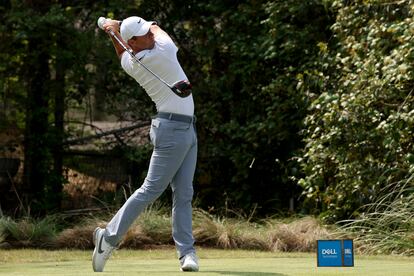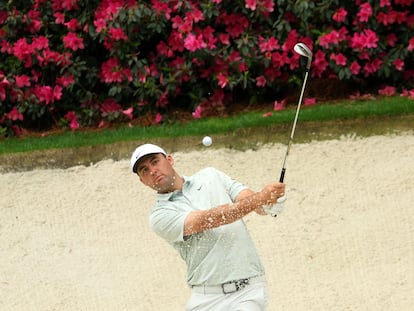Golf takes steps to rein in the big hitters
The sport’s governing bodies have proposed introducing a heavier ball to counter the constant increases in distance players are achieving

Faster, higher, stronger. Golf is flexing its muscles to display its Olympic credentials. Balls that travel almost 300 meters off the tee, chewing up two-thirds of the fairway and exceeding speeds of 300 kilometers per hour. The sport that gave birth to artists like Seve Ballesteros, capable of creating shots with the magic of their hands, is today is a contest of big-hitters who smash the ball like a cannon shot. Year after year, the distance that golfers can send a tee shot with their state-of-the-art drivers has increased as steadily as the speed of their projectiles. Last year witnessed the highest average ever recorded on the PGA Tour in terms of meters gained with the most powerful club, 274m, as well as the highest average ball speed ever recorded at 276.5 km/h.
The two governing bodies of world golf, the USGA and the British Royal and Ancient, have proposed a measure to rein in these big-hitters: a ball modified to travel up to 10% less. The idea, applicable from 2026 and only in professional tournaments, has opened up a debate: golf would be split into different categories at amateur and professional level.
The current regulation balls have a maximum weight of 45.93 grams and a minimum size of 42.67 millimeters in diameter. It is a missile. In 1987, the first year for which statistics are available on the PGA Tour, balls traveled an average distance of 240 meters. This year, the leader in this classification, Rory McIlroy, has got close to 300m, a barrier that has never been broken. The Northern Irishman also leads the way in the percentage of the length between tee and hole he covers with his tee shot at 67% (the average on the tour stands at 63%). The seven highest historical marks in this category have all been achieved in the last seven years: the ball is flying further and faster than ever. When speeds were first measured, in 2007, the odometer reached 266km/h on average. In 2022, that had increased to 276.5km/h. So far in 2023, 277.7km/h has been recorded. The peaks are breathtaking: a drive by Scott Stallings at last season’s Phoenix Open traveled 420 meters. Cameron Champ also broke the record for the fastest ball ever hit.
Courses have been forced to act, even if that means merely touching up a museum like Augusta National. The course that will host the Masters this week has been extended again. The 13th hole, Azalea, which Sergio Garcia named his daughter for, is a par five that marks the end of the Amen Corner triangle. The tee has been moved back to increase the hole’s length from 510 yards (466 meters) to 545 yards (498m) to prevent players from reaching the green with a second shot using short and medium irons. It was at Augusta that Tiger Woods won his first major in 1997 by destroying the course at 18 under par, 12 shots ahead of second-placed Tom Kite. Woods’ exhibition led golfers to hit the gym and launched the game into another dimension. Power came into play. That combination of finely tuned athletes and the latest club technology (a driver weighs as little as 300 grams) has produced a whole new sport.
One of the greatest drives you will EVER see 🤯@McIlroyRory drives the ball to 3 FEET at the 375-yard par-4 18th with a 349-yard carry to the green! pic.twitter.com/HzhMBtyKkr
— PGA TOUR (@PGATOUR) March 23, 2023
The leap over the past 25 years has been so marked that with the average distance Woods reached at Augusta in 1997 (270m) it would place him at 128th on the hitting ranking today, below the average on the American circuit. “The ball flies too far,” Woods warned six years ago as he was overtaken by the new crop of athletes. Today that throne belongs to McIlroy, who is capable of astonishing feats like hitting the green on the par-four 18th hole during the recent Match Play tournament with a 349-yard drive.
The Northern Irishman admits he can’t remember the last time he used every club in his bag, another sign that golf is losing its variety. McIlroy is not against the introduction of a heavier ball. Others, like Jon Rahm, are against it. “I don’t know why they are so focused on making golf more difficult than it already is. If the ball flies less it will hurt players who have less distance more. We’re in a golden age of golf. Why fix it if it isn’t broken? There are lots of way to make it more difficult for us: the design of the courses, the preparation of the courses...” says the 2021 U.S. Open winner, who placed fifth last year in distance (292m on average) and has registered a drive speed of 303 km/h.
Rahm is about 20 yards ahead of Tiger’s record at the turn of the century, precisely the pinch the USGA and the Royal and Ancient want to lower while also preventing some courses from being ridiculed by exceptional scores: Cameron Smith won the 2022 Sentry with a scorecard of 34 under, with Rahm second on 33 under. In 2020, golf’s governing bodies published a 102-page report warning of the drift: “Golf is not a better game if each generation hits the ball further than the last. Other sports don’t have to change their stadiums. Swimming pools and tennis courts don’t get longer. But golf courses are getting bigger and bigger, and increasing distance can lead to a loss in shot creativity. That threatens the future of our sport.” In 2021, the USGA and the Royal and Ancient pushed to reduce the maximum length of a club from 48 inches (1.22 meters) to 46 inches (1.17m), a change that did not affect putters. Now, it is the turn of the ball.
The issue is so complex that two of the four major tournaments, the US Open and the British Open, could be played with the heavier ball while the remainder of tournaments use the current one, as those two tournaments are organized by the promoters of the revolution. “I would leave it as it is,” says Jorge Campillo, recent winner on the European circuit. “Golf should be played by everyone with the same balls, professionals and amateurs. It’s true that some courses are becoming short because people are hitting the ball further and further, but very few golfers play professional tournaments. It is absurd, complicated and requires a lot of logistics.” Rahm sums up the issue: “It would generate a huge division in golf.”
Distance and speed statistics on the PGA Tour
Sign up for our weekly newsletter to get more English-language news coverage from EL PAÍS USA Edition
Tu suscripción se está usando en otro dispositivo
¿Quieres añadir otro usuario a tu suscripción?
Si continúas leyendo en este dispositivo, no se podrá leer en el otro.
FlechaTu suscripción se está usando en otro dispositivo y solo puedes acceder a EL PAÍS desde un dispositivo a la vez.
Si quieres compartir tu cuenta, cambia tu suscripción a la modalidad Premium, así podrás añadir otro usuario. Cada uno accederá con su propia cuenta de email, lo que os permitirá personalizar vuestra experiencia en EL PAÍS.
¿Tienes una suscripción de empresa? Accede aquí para contratar más cuentas.
En el caso de no saber quién está usando tu cuenta, te recomendamos cambiar tu contraseña aquí.
Si decides continuar compartiendo tu cuenta, este mensaje se mostrará en tu dispositivo y en el de la otra persona que está usando tu cuenta de forma indefinida, afectando a tu experiencia de lectura. Puedes consultar aquí los términos y condiciones de la suscripción digital.
More information
Archived In
Últimas noticias
There is as much life left to discover on planet Earth as that which is already known
Dozens presumed dead, around 100 injured in fire at Swiss Alps bar during New Year’s celebration
Is porn for women different from conventional porn? We spoke to those who make it
Cartagena de Indias is sinking: What can the city do to mitigate it?
Most viewed
- Reinhard Genzel, Nobel laureate in physics: ‘One-minute videos will never give you the truth’
- David King, chemist: ‘There are scientists studying how to cool the planet; nobody should stop these experiments from happening’
- Oona Chaplin: ‘I told James Cameron that I was living in a treehouse and starting a permaculture project with a friend’
- Sinaloa Cartel war is taking its toll on Los Chapitos
- The Interoceanic Train, the Mexican alternative to the Panama Canal











































